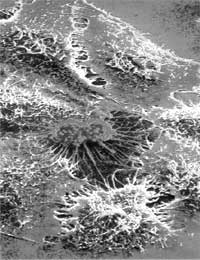Where cancer lurks
 till date, the exact cause for leukaemia or cancer of the blood-forming cells is not known. Some researchers have maintained that a microbe - a bacterium or a virus - could well be the cause of the disease and research is being conducted to identify it. Now, a study brings up rather strong evidence suggesting that "leukaemia clusters" are triggered by infections that occur in areas were most of the residents are migrants.
till date, the exact cause for leukaemia or cancer of the blood-forming cells is not known. Some researchers have maintained that a microbe - a bacterium or a virus - could well be the cause of the disease and research is being conducted to identify it. Now, a study brings up rather strong evidence suggesting that "leukaemia clusters" are triggered by infections that occur in areas were most of the residents are migrants.
This study was taken up at Seascale in Cambria, Britain, which is close to the Sellafield nuclear plant. This area has the best-known cluster of childhood leukaemia, the rate being almost 10 times higher than that in the rest of the country. Expectedly, in view of the nuclear plant, radiation was blamed for the high number of cancer cases. But, in 1988, Leo Kinlen of the University of Oxford, Britain investigated the disease and proposed the so-called "population mixing" theory.The theory postulates that when a large number of people move to a new area, the immunity passed down by migrant mothers may not prepare their children to fight off the particular strain(s) of viruses and bacteria found in the area.
Now, two researchers Heather Dickinson and Lousie Parker of the Royal Victoria Infirmary, Newcastle-upon-Tyne looked at the issue in the light of Kinlen's hypothesis. They examined the medical records of 120,000 children born in Cambria between 1969 and 1989. They found that if both parents came from outside Cambria, the probability of their child developing leukaemia during the first six years was 2.5 times higher than when one of them was from Cambria.
The trend in densely-populated areas was even more startling. If 80 per cent of the parents were migrants, the risk was 11 times higher than in areas were fewer parents were migrants ( British Journal of CancerM , Vol 81, No 2). To add credence to their findings, the analysts initially predicted the number of childhood leukaemia in Seascale itself based on the rest of Cambria. They predicted three cases of acute leukaemia. To their surprise, the actual occurrence doubled the projected figure. Richard Doll of the University of Oxford, who proved the link between smoking and lung cancer, believes the Seascale study establishes Kinlen's hypothesis.
However, Dickinson would not like to overstate the "leukaemia can be contagious" issue due to obvious reasons. He says that Kinlen's theory is supported by their research that childhood leukaemia might result from a rare response to a common, but unidentified, infection. And that there is an increased risk of such infections when previously separate populations mix.
Dickinson says that this is very different from saying that childhood leukaemia itself is an infectious disease. If people are led to believe that childhood leukaemia is an infectious disease, Dickinson says, they are likely to avoid contact with children suffering from leukaemia, which could increase the isolation, suffering and distress of these children and their families.
But what kind of infection can trigger leukaemia? Dickinson is unsure: "We think it is probably something common and that most children get over it." Meanwhile, other researchers are pursuing the lead using the state-of-the-art technology. Microbiologists from the Leukaemia Research Fund's Virus Research Centre in Britain are searching for traces of viral dna in blood cells from leukaemic parents, whether and the type of bacteria/virus that have been passed on to their children.
